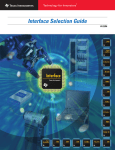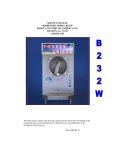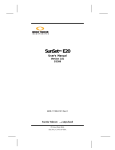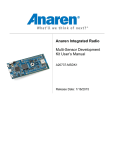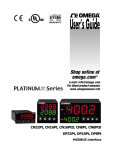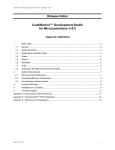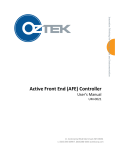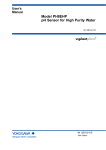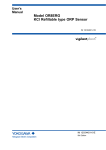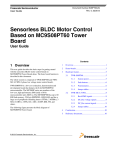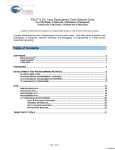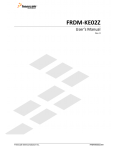Download Deep Dive on Kinetis E Series MCUs with 5 V I/O and High EMC
Transcript
Deep Dive on Kinetis E Series MCUs with 5 V I/O and High EMC Performance FTF-IND-F0471 Allen Lv | Product Marketing William Jiang, Dennis Lui | Application M A Y. 2 0 1 4 TM External Use Agenda • • • • • • Kinetis E MCU Overview by Marketing Deep Dive of Key Features Real Case EMC Design Guideline Freedom and KE0x Peripheral Driver Lib Demo Summary TM External Use 1 Kinetis E Overview TM External Use 2 Market Needs 5V 32b KE Appliance MCU TAM Key Segment – Appliances $M 2010 2014 Target Customers Changing Product Mix in Appliance 2010 2014 16/32-bit TAM Grows from $143M to $278M TM External Use 3 Kinetis E Strong Robustness High Efficiency Low Cost Strong Robustness – EMC/ESD design technology ensure strong noise immunity performance High Efficiency – Cortex-M0+ core up to 48MHz and 40x more than 8/16-bit MCUs Low Cost – Optimized for cost-sensitive applications offering low pin count option TM External Use 4 Kinetis E-Series: Target Market • • • • • • • • • • Appliance DC fans Sewing Machine Elevator PLC Offline UPS Metering Breaker Surge Protection DC/DC Where need Robustness Timers System 6ch Flex Timer PMU 2 ch FlexTimer Watchdog PIT LVD / POR PWT RTC CRC Core Complex ARM CortexTMM0+ Up to 48 MHz Single cycle 32bit x 32-bit multiplier Single cycle I/O access port Analog 12-bit ADC 2 x Analog Comparator Clocks 1% IRC Ext OSC Bit manipulation engine FLL Memory Interfaces HMI Security Serial Interfaces Up to 128KB Flash Up to 71 GPIO 64-bit unique identification (ID) number 3 x UART Up to 512B EEPROM KBI 2 x SPI 2 x I2C Up to 16KB RAM 1 x CAN Where need Low Cost and High Performance TM External Use 5 Kinetis E Series Kinetis E Series Product Roadmap 2.7-5.5V MCUs with high reliability and robustness, Based on ARM® Cortex-M® with best-inclass Enablement Concept KE1xF – High Performance, Mix Signal Planning KE1xZ – General Purpose, ROM, DMA KE0xZ – Entry Level Execution Integration Production KE1xF: High Performance Mix Signal KE1xZ KE1xZ KE1xZ KE1xZ KE1xZ KE06Z KE06Z KE1xF KE1xZ: Performance enhancement Feature optimization MP Q1/14 MP Q1/14 KE04Z KE04Z KE02Z 8KB KE1xF 16KB KE02Z KE02Z 32KB 64KB KE04Z Now! 128KB Memory Density TM External Use 6 KE0xZ: M0+ with base feature set. 256KB 512KB Kinetis E-Series: MCU Families Common Features Optional Features Key Features System Family ARM Cortex-M0+ Core, 48MHz [1] Speed Flash SRAM CAN Multiple power modes, Clock Gating, 2.7V – 5.5V Operating Temp: -40 to 105°C √ Seg. LCD PWT Fast Timer ADC √ √ 12-bit KE06Z 48MHz 64-128KB 8-16KB KE04Z128 48MHz 128KB 16KB √ √ 12-bit KE04Z64 48MHz 64KB 8KB √ √ 12-bit KE04Z8 48MHz 8KB 1KB √ √ 12-bit KE02Z 20MHz/ 40MHz 16-64KB 2-4KB Clock Management External OSC, 4~20MHz, 32KHz Internal OSC, 32KHz, 1KHz Analog Peripherals 12-Bit ADC Analog Comparators Serial Interfaces SCI SPI, IIC Timers Real Time Clock 16bit Flex timers 32bit Periodic Interrupt Timer [1] 20MHz/40MHz for KE02 TM External Use 7 12-bit TSI Kinetis E0x Series Master Block Diagram Key Features: • Core/System − • Memory − − • 128KB Flash LVD/POR 256B EEPROM Clocks 16KB SRAM FLL Ext OSC 2.7~5.5V PMC Int OSC BME Int LPO 1 x CAN Multiple serial ports, 3 x UART / 2 x SPI / 2 x I2C 16ch 12-bit ADC 2x ACMP Security and Integrity Analog Timers CRC 12-bit ADC 3 x FlexTimer 2x I2C 2x SPI KBI UID 2 x ACMP PIT 3x UART 1x CAN GPIO 1 x 6ch FTM 2 x 2ch FTM 1 x PIT 1 x PWT RTC Up to 71 I/Os 2.7-5.5V, -40 to 105oC Packages: 80/64/44/32 LQFP, 64QFP 24QFN, 20SOIC, 16TSSOP Pin compatible within KE TM External Use 8 Communication Interfaces HMI PWT 8 pins 20mA RTC 2 pins open drain Others − − • Watchdog up to 128KB Flash up to 16KB SRAM Timers − − − − − • ARM® Cortex® -M0+ 48MHz Debug Interfaces Memories Analog − − • System Communications − − − • ARM ® Cortex ® -M0+ up to 48MHz Core Kinetis E Series: Selling Point - Robust Feature category Feature Benefit to customer Robust Improved 5V I/O pad with digital filter Better EMC performance and system robust in the harness environment and easy for PCB layout Safety IEC60730 compliant watchdog, CRC and certified IEC60730 safety S/W library Makes system more safer while reducing system cost by removing external BOM TM External Use 9 Kinetis E Series: Selling Point - Efficiency Feature category Feature Benefit to customer Fast processing Single cycle 32bx32b ARM Cortex-M0+ core Much higher performance than M0, and 8/16-bit MCUs Fast response Nested Vectored Interrupt Controller True hardware interrupt nesting and less interrupt latency than M0 and 8/16-bit MCUs Fast response 12-bit x 16ch SAR ADC with 8-entry FIFO Provide faster sampling rate, higher resolution, and faster response Fast response 2x ACMP with 6-bit DAC Provide over-current, over-voltage protection as well as zero-crossing detection for full voltage range. Fast response Bit manipulation engine Support bit-band on peripherals that extends the core instructions and generates more efficient code Fast response Single cycle fast GPIO Provide faster response bit-banging and software protocol emulation without additional BOM TM External Use 10 Kinetis E Series: Selling Point - Application Special Feature category Feature Benefit to customer Motor control 6-ch 16-bit Flextimer optimized for motor control with sync to ADC via PDB Make motor control easier High drive Up to 8 high drive pins with each supporting 20mA Provide direct connection to LED drive circuit without additional cost Data endurance Up to 256B EEPROM with 500K endurance cycles Provide longer life time of the NVM SMBus SMBus compatible IIC Make SMBus connection easier without additional overhead TM External Use 11 Kinetis E Series: Selling Point - Save Cost Feature category Feature Benefit to customer Scalable & Pin-Compatible Wide range of packages with pincompatible Makes code easy to reuse and platform design easier Low PCBA cost 0.8mm pitch package (64QFP) Cost down PCBA process Lost cost development tool CW special edition free for 64KB Cost down development TM External Use 12 Kinetis E EMC Performance Robustness in EFT,PESD and AC Power Relay Tests Test Conditions • Microwave Oven Controller board with KE02 as main control MCU • Board and System level tests based on − − − KE02 Controller Board IEC 61000-4-4(EFT) IEC 61000-4-2(PESD) China Appliance local AC Power Relay test Test Results • Board level − − − − − • IEC 61000-4-4(EFT):+/- 4.4kV* IEC 61000-4-2(PESD): Indirect Contact Discharge +/- 20kV China Appliance local test on AC Power Relay: 6-turns without Reset System level − − − − IEC 61000-4-4(EFT):+/- 4.4kV* IEC 61000-4-2(PESD): Contact Discharge(at the case) +/- 20kV IEC 61000-4-2(PESD): Air Discharge (at the control panel) +/- 15kV *Limited by the test equipment max output voltage TM External Use 13 Microwave Oven with the KE02 Controller Board Deep Dive of Key Features – Cortex-M0+ TM External Use 14 ARM Cortex-M0+ Processor: The True 8-bit Replacement • The smallest, lowest-power ARM processor on the market • Compatible with all other Cortex-M cores • The most energy-efficient 32-bit processor ever designed • Single-cycle 32bx32b instruction • Significant energy efficiency advantages over 8/16-bit • Processor consumption as low as 9.8μW/MHz in 90nm process, or 52 µW/MHz in 180nm process • Outstanding results of 1.77 CoreMark/MHz • I/O low-power improvements with single cycle access to critical peripherals (GPIO …) • Relocatable vector table allows for dynamic exception handlers by moving the vector table into RAM • Micro trace buffer brings fast debug advantages of trace to low-end MCUs (not implemented in KE0x) TM External Use 15 ARM Cortex-M0+ The next-generation entry-level processor 32-bit Performance and Functionality With 8-bit Ease-of-Use Streamlined Architecture The new cortex-M0+ core strikes the right balance of performance and simplicity needed in entry-level applications. Accelerated Debugging Micro trace buffer accelerates software debug without wasting additional I/O. Plus, get faster bug identification and correction with minimal system resources. (Micro trace buffer not implemented in KE0x) Closer to the Hardware CoreMark Code in kB Single-cycle IO and peripheral bus facilitate bit-banding and software protocol emulation, keeping it an 8-bit ‘look and feel’. Ultimate Code Density Cortex-M0+ instruction set provides the most compact code even when compared to legacy 8- and 16-bit architectures. Do more with the same Flash size. CoreMark code compiled optimized for size. A, B, C & D TM External Use 16 Benefits of Moving from 8/16-bit to 32-bit ARM Cortex-M0+ 8/16-bit 32-bit ARM Cortex-M0+ Performance Performance •Older, slower architectures & technology •2x to 40x more than 8/16-bit, 9% more than Cortex-M0 •Increased code size/complexity when performing complex math operations •Fast 32-bit math processing Energy-Efficiency Energy-Efficiency •Low energy-efficiency •>2x CoreMark/mA than closest 8/16-bit MCU, +30% / CM0 Low Cost Low Cost •6-35kgates •12-35kgates •Variable code density •Excellent code density Ease-of-Development Ease-of-Development •Limited addressable memory •Linear 4GB address space – no need for paging •Simplistic interrupt controllers •Full-featured interrupt controller – simpler s/w architecture •Limited scalability (MHz, flash, features) •Huge scalability – h/w and s/w reuse across end products •Limited ecosystem support •Huge ARM ecosystem – off-the-shelf software/tools/training •Fast single-cycle access to I/O •Micro Trace Buffer – lightweight, non-intrusive trace (not implemented in Kexx) TM External Use 17 Cortex-M Processor Family High performance data processing & I/O control. Support hardware divide, MAC, bit field processing, DSP. Floating point unit optional (Cortex-M4F). Cortex-M4 Cortex-M3 High performance data processing & I/O control. Support hardware divide, MAC (Multiply Accumulate) , bit field processing. Cortex-M0+ General data processing, high performance I/O control, mixed signal ASICs, replacement for 8/16-bit MCUs Cortex-M0 General data processing, I/O control, mixed signal ASICs, replacement for 8/16-bit MCUs Cortex-M1 For FPGA designs only. Optimized for FPGA and can work in most FPGA devices TM External Use 18 ARMv7-M architecture New ARMv6-M architecture Common Features • Many features are available on all Cortex-M Microcontrollers − NVIC - Nested Vector Interrupt Controller − Sleep modes and low power features − OS support features such as SysTick timer − CMSIS-Core support (API software for processor feature) − Debug support − Different subset of Thumb-2 Instruction Set Architecture • Architecture consistency means − Using the same tool chain − Easy program code reuse − Multi-sources possible TM External Use 19 NVIC Feature Comparisons TM External Use 20 Interrupt Controller (NVIC) • The Cortex-M family uses a number of methods to improve interrupt latency. The first one is called tail chaining. And the second method is called late arrival. The third one is Stack pop pre-emption. Tail chaining operation TM External Use 21 Interrupt Controller (NVIC) • Late arrival operation TM External Use 22 Interrupt Controller (NVIC) • Stack pop pre-emption operation TM External Use 23 Single cycle GPIO • Provide faster response bit-banging and software protocol emulation without additional BOM • • Up to 50% faster than normal I/O Fast GPIO controller (FGPIO) have SET/CLEAR/TOGGLE control for all pins in zero wait states Enabling highest speed I/O for efficient I/O and peripheral access TM External Use 27 Other Key Features TM External Use 28 Bit Manipulation Engine • The BME is a hardware block that resides between the platform and E-Series Core that allows read-modify-write operations to be performed on peripheral registers using data stored in the target address − Decorated AND, Stores OR, XOR and Bit field insert (BFI) − Decorated Loads Load and clear one bit (LAC1), Load and Set one bit (LAS1), Unsigned bit field extract (UBFX) Peripherals Core Accesses BME TM External Use 29 Bit Manipulation Engine (BME) BME decorated references are only available on system bus transactions generated by the processor core TM External Use 30 Example: Decorated Store Logical AND • The data size is specified by the write operation and can be byte (8 bit), halfword (16 bit) or word (32 bit). The core performs the required write data lane replication on byte and halfword transfers. • where addr[28:26] = 001 specifies the AND operation, and mem_addr[19:0] specifies the address offset into the peripheral space based at 0x4000_0000. The "-" indicates an address bit "don't care". • Typical operation GPIOA_PDOR &= 0x02 • BME operation *( (unsigned long *)0x440ff000) = 0x02 TM External Use 31 BME vs C code for Bit field insertion with highest speed optimization • C code for bit field insertion without BME 0x1128: 0x6ae0 0x112a: 0x4028 0x112c: 0x21a0 0x112e: 0x02c9 0x1130: 0x4301 0x1132: 0x62e1 • LDR ANDS MOVS LSLS ORRS STR R0, [R4, #0x2c] R0, R0, R5 R1, #160 R1, R1, #11 R1, R1, R0 R1, [R4, #0x2c] 11 cycles, 12 bytes ; 0xa0 C code for bit field insertion with BME BME_BITFIELD_INSERT(u32Addr,16,4) = u32Data; /* write 5 to bit 19..16 */ 0x115e: 0x482d LDR.N R0, ??DataTable14_9 ; 0x5818f040 (1478029376) 0x1160: 0x21a0 MOVS R1, #160 ; 0xa0 0x1162: 0x02c9 LSLS R1, R1, #11 0x1164: 0x6001 STR R1, [R0] 10 cycles, 8 bytes Speed improved by 9% Code size improved by ~33% TM External Use 32 Bit-band (KE04 and KE06) • • • • Support uninterruptible atomic read-modifywrite operation on RAM-U Two 32 MB aliased bit-band regions associated with the two 1 MB bit-band spaces, functional on RAM-U Each 32-bit location in the 32 MB space maps to an individual bit in the bit-band region A 32-bit write in the alias region has the same effect as a read- modify- write operation on the targeted bit in the bit-band region −A 32-bit write in the alias region returns either Writing a value with bit 0 set writes a 1 to the target bit. Writing a value with bit 0 clear writes a 0 to the target bit. −A a 32-bit read in the alias region returns either value of 0x0000_0000 to indicate the target bit is clear a value of 0x0000_0001 to indicate the target bit is set TM External Use 33 FLASH Memory Controller: FMC • The FMC sits between the platform masters (Core) and the Flash, accelerates access time with buffers which will provide 0 wait state access times when hit. • Each access of the Flash pulls next 32-bits into the FMC cache buffer, This way we move 2 instructions and can deliver full performance to the 48MHz bus from the 24Mhz Flash bus. • When flash cache enabled, the power consumption is also improved AXBS Flash FMC 32 32-bit prefetch speculation buffer 4-Way by 2-set x 32-bit cache for a total of 32bytes TM External Use 34 32 Flash and EEPROM • Flash memory − − 64-bit security and backdoor key Automated program and erase algorithm with verify Fast sector erase (sector size = 512B) and longword (32-bit) program operation Flexible protection scheme to prevent accidental program or erase of flash memory − − • Accessible 64-byte in hidden non-volatile information block Ability to set flash read margin levels EEPROM − − − − − − − Single-bit fault correction and double-bit fault detection within a word during read operations Automated program and erase algorithm with verification and generation of ECC parity bits Fast sector erase (sector size = 2B) and byte program operation Protection scheme to prevent accidental program or erase of EEPROM memory Ability to program up to four bytes in a burst sequence Ability to set EEPROM read margin levels 500K program/erase cycles NVM Control ler KE0x family has another new flash operation feature: read-while-write. It allows read from flash while programming/erasing the flash by setting Enable Stalling Flash Controller bit in MCM_PLACR TM External Use 35 Pulse Width Timer (PWT) • • • • • • • • • • Capture signal period/frequency directly by h/w in 16-bit resolution Provide highest response to system Reduce CPU overhead Can measure positive and/or negative pulse width Programmable triggering edge for starting measurement Programmable measuring time between successive alternating edges, rising edges or falling edges Programmable prescaler from clock input as 16-bit counter time base Two selectable clock sources—bus clock and alternative clock Four selectable pulse inputs Programmable interrupt generation upon pulse width value updated and counter overflow Positive TM External Use 36 Negative 4-wire I2C support • • • • • • • • • • • Flexible to interface with external custom line drivers Provide higher bus drive capability Provide higher noise immunity in EMC environment Reduced total system BOM SMBus spec v2 compatible 5-bit glitch input filter Range slave address recognition Arbitration-lost interrupt with automatic mode switching from master to slave Programmable glitch input filter Low power mode wakeup on slave address match Can be disabled to support traditional 2-wire bi-dir I2C TM External Use 37 Controller Area Network (CAN) • • • • • • • • • • Fully compliant with CAN 2.0A/B protocol Automotive proven leading edge CAN controller popular in tough noise EMI environment 5 Receive buffers with FIFO storage scheme 3 Transmit buffers with internal prioritization using a ‘local priority’ concept Flexible maskable identifier filters to receive wanted messages Programmable functionality: − Wake-up with integrated low-pass filter − Loop-back mode supports self-test operation − Listen-only mode for monitoring of CAN bus − bus-off recovery functionality Separate signaling and interrupt capabilities for all CAN receiver and transmitter error states (Warning, Error Passive, Bus-Off) Programmable clock source either system clock or crystal oscillator output Internal timer for time-stamping of received and transmitted messages Low power modes: Sleep, Power Down and MSCAN Enable Vcc Tx Rx ECU 1 RT 120Ω Gnd CANH CANL ECU 2 ... ECU n Stubs < 1m RT Twisted-pair media TM External Use 38 120Ω Controller Area Network (CAN) CPU Interface (Memory Mapped I/O) msCAN Receive / Transmit Engine Slide 39 0 Tx TXE0 0 PRIO Internal Priority Scheduling 1 TXE1 0 Tx 1 TXE1 Tx Message CAN 1 1 PRIO PRIO 1 1 Tx TXE2 2 PRIO MSCAN Global Identifier Filtering: 2 x 32 bit CPU Bus FIFO MSCAN RxFG or 8 x 8 bit Rx 0 Rx 1 Rx 2 Rx 3 Rx 4 RxBG or 4 x 16 bit TM External Use 39 RXF CPU Bus IEC60730 Safety Standard Class B Cert. for Household Appliance • IEC60730 safety standard classification: − Class A: Not intended to be relied upon for the safety of the equipment − Class B: To prevent unsafe operation of the controlled equipment − Class C: To prevent special hazards TM External Use 40 IEC60730 Safety Standard Class B Cert. for Househoud Appliance • IEC60730 safety standard peripherals − Watchdog: independent clock source and robust refresh & protection mechanism, provide safety mechanism to monitor The flow of the software Interrupt handling & execution CPU clock (too fast, too slow and no clock) − Cyclic Redundancy Check (CRC): provides a fast mechanism for Testing the Flash memory Check on serial communication protocols (UARTS, I2C, SPI) TM External Use 41 type Simple Power Mode condition core/bus clock VDD clock gating IDD ON 10.70m A OFF 9.23mA ON 9.75mA OFF 8.27mA ON 8.53mA OFF 7.04mA ON 7.60mA OFF 6.10mA 5V Core power mode 40M:20M System/chip power Mode RUN RUN Sleep WAIT Deep sleep STOP 3V RIDD run code in Flash FEI mode 5V 20M:20M 3V type core/bus clock condition VDD 5V 40M:20M WIDD 3V Wait mode, run code in Flash 5V 20M:20M 3V - LVD off SIDD LVD on LVD off, ADC on 5V 3V 5V 3V 5V 3V TM External Use 42 clock gating IDD ON OFF ON OFF ON OFF ON OFF - 7.46mA 5.98mA 6.51mA 5.03mA 6.95mA 5.47mA 6.01mA 4.53mA 1.2uA 1.1uA 126.8uA 122.8uA 39.7uA 39.2uA RIDD RIDD run code in Flash FEI mode enable most modules 11.19m A 10.24m A 5V ON 3V ON 5V ON 8.94mA 3V ON 8.01mA 5V ON 3V ON 5V ON 3V ON 40M:20M 20M:20M run code in Flash 40M:20M FEI mode enable most modules while to access 20M:20M SRAM 13.96m A 12.83m A 11.265 mA 10.246 mA Module to Module Interconnection TM External Use 43 Use case1: FTM2 sync ADC while ACMP generates fault to FTM2 + ADC … AD0 AD1 Delay INITTRG/ FAULTn MATCHTRG AD15 TRIGn FTM2 TM External Use 44 ACMP0 - Use case2: UART0 TXD modulation for Infrared UART0 UART0_TX FTM0 CH0 TXDME TM External Use 45 Use case3: UART0 RX filter for Infrared demodulation UART0_RX RX UART0 ACMP0 - + RXDFE TM External Use 46 Use case4: UART0 RX capture by FTM0 ch1 RX UART0 UART0_RX FTM0 CH1 FTM0_CH1 RXDCE TM External Use 47 Fast FlexTimer (FTM) • Optimized for motor control and power conversion applications • FTM clock as high as CPU clock ( up to 48MHz) • Generation of independent, complementary and asymmetric PWM • Hardware dead time insertion • Rich PWM synchronization scheme and fault protection • PWM output masking and polarity control • Enhanced triggering functionality (channel match trigger and init trigger) KE02 • • • • • • • • Dual edge capture Immediate PWM registers load Invert control/channel swap Fault input polarity control Programmable TOF frequency Software output control Debug mode function (The FTM can be set to still function when the debug mode is entered) Can sync with ADC via programmable delay block PWM 1A PWM 3A PWM 5A 6-ch deadtime PWMPWM 2A PWM 4A PWM 6A sync FlexTimer System clock 8-bit programmable delay block PWM Signal Trigger ADC Sync Pulse ADC Trigger Time delay Conversion TM External Use 48 FlexTimer • Complementary PWM − Channel <n> controls first edge of PWM, while <n+1> controls 2nd PWM edge TM External Use 49 FlexTimer • Deadtime insertion − Deadtime insertion on either rising edge or falling edge − Counter clock derived from 1/4/16 system clocks − Count from 1 to 63 − Dead time from 1 to 1008 system clocks ( 0.05 to 50.4us @20MHz ) TM External Use 50 FlexTimer • PWM synchronization − Provide opportunity to force FTM counter to its initial value (CNTINH:L) and the channel outputs are forced to initial value (known as FTM counter synchronization) and update 3 kinds of registers (MOD, CnV, OUTMASK[CHnOM]) with their write buffers and sync two or more FTMs − Trigger Update • event: hardware trigger or software trigger point: boundary cycle Minimum/low boundary (FTM counter == CNTINH:L ) Mod1 Mod 0 FTM counter Init0 Init1 Sync TM External Use 51 FlexTimer • PWM Synchronize with ADC sampling helps to filter the measured current – anti-aliasing − noise free sampling possible when the switch is inactive − Conversion at the point when the shunt resistor signal is available − ADC Sampling and Average Current PWM Period Phase Current Shunt Resistor Signals PWM top PWM Bottom A/D calc. TM External Use 52 FlexTimer Fault Protection − Channel outputs are forced to a safe value when a fault is detected • Up to 4 fault control input pins with fault filters able to filter glitches of 15 system clocks wide • Manual fault clearing (output re-enabled only when Fault flag cleared by s/w) and automatic fault clearing (output re-enabled when fault input returns to 0) Automatic fault clearing Manual fault clearing FTM counter Channel output Without fault Fault input Channel output With fault Fault flag TM Fault flag cleared 53 External Use Fault flag cleared FlexTimer Dual Edge Capture − One-shot or continuous mode • Pulse width measurement • Period measurement TM External Use 54 ADC with 8-entry FIFO • • • • • • Linear Successive Approximation algorithm with 8-, 10-, or 12-bit resolution Up to 16 external analog inputs, external pin inputs, and 5 internal analog inputs including internal bandgap, temperature sensor, and references Single or Continuous Conversion (automatic return to idle after single conversion) Operation in wait or stop3 modes for lower noise operation Automatic compare with interrupt for less-than, or greater-than or equal-to programmable value 8-entry channel FIFO and result FIFO to minimize the CPU overhead − Configurable FIFO depth from 2 to 8 entries as FIFO full condition − When channel FIFO is full: For • Immediately start the first channel conversion, after the previous conversion completes, start the next conversion until the conversion of the last channel in FIFO depth completed, set conversion complete COCO flag For • software trigger mode hardware trigger mode When the first trigger occurs, start the first conversion, after previous conversion completes and when the next trigger occurs, start the next conversion until all channels in FIFO depth completes conversion, then set conversion complete COCO flag TM External Use 55 ADC with 8-entry FIFO FIFO scan mode − − − Always use the first dummied channel in spite of the value in the input channel FIFO to simplify the dummy work of input channel FIFO ADC conversion start to work in FIFO mode as soon as the first channel is dummied; when the previous conversion is completed, start the next conversion until the result FIFO is full and then set conversion complete COCO flag In continuous conversion in which the ADC_SC1[ADCO] bit is set, the ADC starts next round of conversion immediately when all conversions are completed. Input channel FIFO Channel conversion 8 COCO = 1 FIFO Full N N H/W trigger Write ADC_SC1_ADCH H/W trigger 2 2 1 1 H/W trigger Write ADC_SC1_ADCH Write ADC_SC1_ADCH TM External Use 56 ADC with FIFO • ADC hardware trigger selection − RTC overflow/ PIT overflow/FTM2 trigger (match trigger or initialization trigger) with 8-bit programmable delay KE02 ADC triggers RTC ovf PIT 00 ovf 01 Init trig 8-bit delay FTM2 match trig Bus clock 1/2N ADC H/W trigger 10 11 ADHWT NOTE: different devices may have different settings TM External Use 57 Watchdog (WDOG) • • Compliant with IEC60730 safety standard Independent clock source − Internal 32 kHz RC oscillator − internal1 kHz RC oscillator − External clock • • 16-bit Programmable timeout period with optional fixed 256 clock prescaler when longer timeout periods are needed Robust write sequence for counter refresh − Refresh sequence of writing 0x02A6 and then 0x80B4 MUST be within 16 bus clocks TM External Use 58 Watchdog (WDOG) • Window mode option for the refresh mechanism − Programmable 16-bit window value − Provides robust check that program flow is faster than expected − Early refresh attempts trigger a reset • Robust write sequence for unlocking write-once configuration bits − Configuration bits and registers are write-once-after-reset, to ensure watchdog configuration cannot be mistakenly altered − Unlock sequence of writing 0x20C5 and then 0x28D9 within 16 bus clocks for allowing updates to write-once configuration bits • Flexible test mode enabling fast testing watchdog in the safety environment (either high 8-bit counter or lower 8-bit counter for comparison) • Backup reset to prevent hardware lockup condition driven by bus clock Reflesh window T0 TM External Use 59 Twindow Toverflow Cyclic Redundancy Check (CRC) • • • • • 16/32-bit CRC code for error detection Programmable 16/32-bit initial seed value Programmable 16/32-bit polynomial Reverse input and output data by bit in a byte (no byte reverse) Final complement output of result TM External Use 60 Name Poly Seed Final XOR ? Type of Transpose for Input Type of Transpos e for CRC Read Standards CRC-16 0x1021 0xFFFF No No transpose No transpose CRCCCITT, ADCCP, SDLC/HDL C (ITU-T V.41) 0x0000 (ITU-T T.30, X.25) CRC-16 0x1021 0 No Transpose only bits in a byte Transpose only bits in a byte CRC-CCITT (Kermit) XMODE M 0x8408 0x0000 No Transpose only bits in a byte Transpose only bits in a byte XMODEM ARC 0x8005 0x0000 No Transpose only bits in a byte Transpose only bits in a byte ARC (zip file) CRC-32 0x04C 11DB7 0xFFFF FFFF Yes Transpose only bits in a byte Transpose both bits and bytes PKZIP, AUTODIN II, Ethernet, FDDI Analog Comparator (ACMP) Positive Input0 M U Input1 Falling edge interrupt Enabl e X + Negative M U X 6b DAC TM External Use 61 Edge Control Rising edge interrupt Either edge interrupt Hyste ris Pin-out FTM1 ch0 SCI0 input Periodic Interrupt Timer(PIT) An array of 32-bit count-down-to-0 timers that can be used to raise interrupts and triggers KE02 has two timers in a PIT Each timer can work independently Two timer can be chained to form a 64-bit timer A timer can be programmed to function in debug mode TM External Use 62 64-bit timer Timer 1 Timer0 EMC Design Guideline for KE0x Real Case EMC Performance with Microwave Oven TM External Use 63 Background • Internal evaluation on EMC performance in board level and system level. • Identify device capability in real application environments. • A simplify microwave oven reference design is developed as a test platform. • Include all hardware, firmware and mechanical design to provide a stable, controllable and precise environment for EMC measurement. TM External Use 64 Test Platform Application: Home Appliance Product: Microwave oven MCU: MKE02Z64VLD2 (64-LQFP) Board: KE02 Controller Board with Power Supply KE02 Controller Board TM External Use 65 Microwave Oven Test Results Board level: • IEC 61000-4-4(EFT):+/- 4.4kV* • IEC 61000-4-2(ESD): Indirect Contact Discharge +/- 20kV • China Appliance local test on AC Power Relay: 6-turns without Reset System level • IEC 61000-4-4(EFT):+/- 4.4kV* • IEC 61000-4-2(ESD): Contact Discharge (at the case) +/- 20kV • IEC 61000-4-2(ESD): Air-Discharge (at the control panel) +/- 15kV *Limited by the test equipment max output voltage TM External Use 66 PCB Layout Recommendation Ground Plane Connection: • Rotate the KE02 package 45 degree for more easy routing on I/O pins. • Fill up a ground plane underneath the MCU and connect all VSS pins together to ensure all VSS pins are kept at same potential level. • The MCU ground plane can be further extended to the package corner points to achieve short ground paths with minimum loop area for other peripheral components around the MCU. • Use separated ground trace to avoid ESD discharge energy directly inject to MCU ground. TM External Use 67 PCB Layout Example 1 (Refer to AN4779) Fill up a ground plane underneath the MCU and connect all VSS pins together with same potential level Minimize the ground loops by use of the corner points for peripheral components around the MCU 5V GND Power supply GND 12V GND Avoid the ESD discharge energy injects into the 5V GND directly TM External Use 68 PCB Layout Recommendation (cont.) Crystal Oscillator Ground Connection: • Place oscillator circuit components as close as possible to the XTAL and EXTAL pins. • Do not place any signal trace near crystal circuit or across the bottom side of the circuit. • Connect crystal oscillator load capacitors ground to the common ground plane. • Route ground traces in the form of a guard ring, along with the traces connecting to the EXTAL and XTAL pins can minimize the noise coupling into the crystal circuit. TM External Use 69 PCB Layout Example 2 (Refer to AN4779) Add a guard ring (a ground trace with no current flow) Connect crystal loading capacitors to a common ground plane Avoid any signal trace near the oscillator circuit or across the bottom side of the circuit Place the oscillator circuit to the EXTAL and XTAL pins as close as possible TM External Use 70 Defensive Software Design • The software design cannot change the physical media which couples the noise into the system, or reduce the absolute magnitude of noise generated from external sources. • The software must be able to identify a particular event if it is a false alarm triggered by noise sources or it is a normal driven event and then make a smart decision on corresponding actions. • Good defensive software design is one of the key factors to improve overall performance, system protection and operating stability in noisy environments (e.g. EMC). TM External Use 71 System Configuration Software can act as Digital Filter to suppress EMC noise TM External Use 72 Implementations • • • • • • • Enable Watch-Dog to avoid code runaway. Refresh data direction setting registers periodically. Fill unused memory to avoid code runaway. Define all interrupt vectors even those that are not used. Select Frequency Locked Loop (FLL) engaged mode. Always re-confirm edge triggered event. Enable digital filter on input port. TM External Use 73 Application Note for EMC • AN4779 − • AN4438 − • Improving the Transient Immunity Performance of Mircocontroller-Based Applications AN1050 − • Designing for Board Level Electromagnetic Compatibility (Chinese Version) AN2764 − • Designing for Board Level Electromagnetic Compatibility AN2321_GB − • How To Develop a Robust Software in Noise Environment AN2321 − • System Design Guideline for 5V 8-bit families in Home Appliance Applications AN4463 − • EMC Design Considerations for MC9S08PT60 AN4476 − • EMC Design Tips for Kinetis E Family Designing for Electromagnetic Compatibility (EMC) with HCMOS Microcontrollers AN1259 − System Design and Layout Techniques for Noise Reduction in MCU-Based Systems TM External Use 74 Application Note for EMC • AN1263 − • AN1705 − • Use of OSC2/XTAL as a Clock Output on Motorola Microcontrollers AN1706 − • Determining MCU Oscillator Start-up Parameters EB396 − • Resetting MCUs AN1783 − • Resetting Microcontrollers During Power Transitions EB413 − • Power-On, Clock Selection, and Noise Reduction Techniques for the Motorola MC68HC908GP32 AN1744 − • Noise Reduction Techniques for Microcontroller-Based Systems AN2015 − • Designing for Electromagnetic Compatibility with Single-Chip Microcontrollers Microcontroller Oscillator Circuit Design Considerations EB398 − Techniques to Protect MCU Applications Against Malfunction Due to Code Run-Away TM External Use 75 Freedom and KE0x Driver Lib TM External Use 76 Kinetis E Series MCUs Entry-level Enablement New Freescale Freedom Development Platform FRDM-KE02Z40M FRDM-KE04Z FRDM-KE06Z • • Product Selection IDE & Code Generation Hardware Freescale & 3rd party IDEs • • • • • Low –cost platform for entry-level developers ($12.95 USD) Features the Freescale open standard embedded serial and debug adapter (OpenSDA). Freescale CodeWarrior IDE v10.5: free 64KB Keil MDK: free 32KB IAR EWARM: free 32KB Atollic TrueStudio: free 8KB GCC ARM Embedded via Launchpad.net Freescale Processor Expert Code Generator • Free software generation tool for device drivers / start-up code • 7 steps from project creation to debug – dramatically reduces development time • Available within CodeWarrior IDE or as a standalone plug-in for IAR/Keil/GNU IDEs GNU TM External Use 77 Solution Advisor www.freescale.com/sa • • Web-based interactive MCU selector Filters for operating characteristics, packaging, memory configuration & peripherals. Verifies muxing compatibility • Save, download and print summary reports and pin mixing configurations Kinetis E: HARDWARE Development Platforms www.freescale.com/FRDM-KE02Z Freedom Platform (FRDM-KE02Z) The Freescale Freedom development platform is a set of software and hardware tools for evaluation and development. It is ideal for rapid prototyping of microcontroller-based applications. The Freescale Freedom KE02Z hardware, FRDM-KE02Z, is a simple, yet sophisticated design featuring a Kinetis E Series microcontroller, the industry’s 5V microcontroller built on the ARM® Cortex™-M0+ core. Features: • MKE02Z64VQH2 MCU – 20MHz, 64KB Flash, 4KB SRAM, 64QFP • Capacitive touch slider, MMA8451Q accelerometer, Tricolor LED • Flexible power supply options – USB, external source • Easy access to MCU I/O • IrDA transmitter and receiver • Thermistor sensor to measuring temperature • Form factor compatible with Arduino ™ R3 pin layout • New, OpenSDA debug interface − Mass storage device flash programming interface (default) – no tool installation required to evaluate demo apps − P&E Debug interface provides run-control debugging and compatibility with IDE tools − CMSIS-DAP interface: new ARM standard for embedded debug interface Refer to the FRDM-KE02Z User’s Manual and OpenSDA User’s Guide for more information. TM External Use 78 Order Now $12.95 Get to know KE02 freedom Reset Button USB OpenSDA IrDA Arduino R3 compatible I/O Header Arduino R3 compatible I/O Header Accelerometer KE02Z64VQH2 Thermistor Arduino R3 compatible I/O Header Arduino R3 compatible I/O Header RGB LED Touch Slider TM External Use 79 KE0x driver library • • • • • • • ARM CMSIS complaint coding format more friendly for ARM users Unified coding style for better readability, reusability, portability, and maintenance. Unified API easy to understand for other module developers More efficient code by using inline functions Cover all on-chip peripherals providing low level driver(register access) and high level driver Rich sample code for each module from simple to complicated API reference manual help user rapid to learn how to use it TM External Use 80 Demo No Labs 1 2 Lab demo for FAT and FCC – contain of IrDA, accelerometer, thermistor, SPI communication, RTC, slip touch down/up to switch demo. Flash demo 3 Low Power demo 4 BLDC demo 5 RTC – calendar with triggering other modules 6 SPI - communication 7 Touch sensing with TSS lib demo 8 UART with interrupt demo 9 Fast GPIO demo 10 Flextimer demo 11 PIT demo 12 ADC FIFO 13 ACMP with trigger and interrupt 14 CRC demo TM External Use 81 Summary • • • • • Presented general Kinetis E overview Deep dive the key features EMC design guideline Talked about freedom and KE0x peripheral driver Demo TM External Use 82 Designing with Freescale Tailored live, hands-on training in a city near you 2014 seminar topics include • QorIQ product family update • Kinetis K, L, E, V series MCU product training freescale.com/DwF TM External Use 83 TM www.Freescale.com © 2014 Freescale Semiconductor, Inc. | External Use


















































































